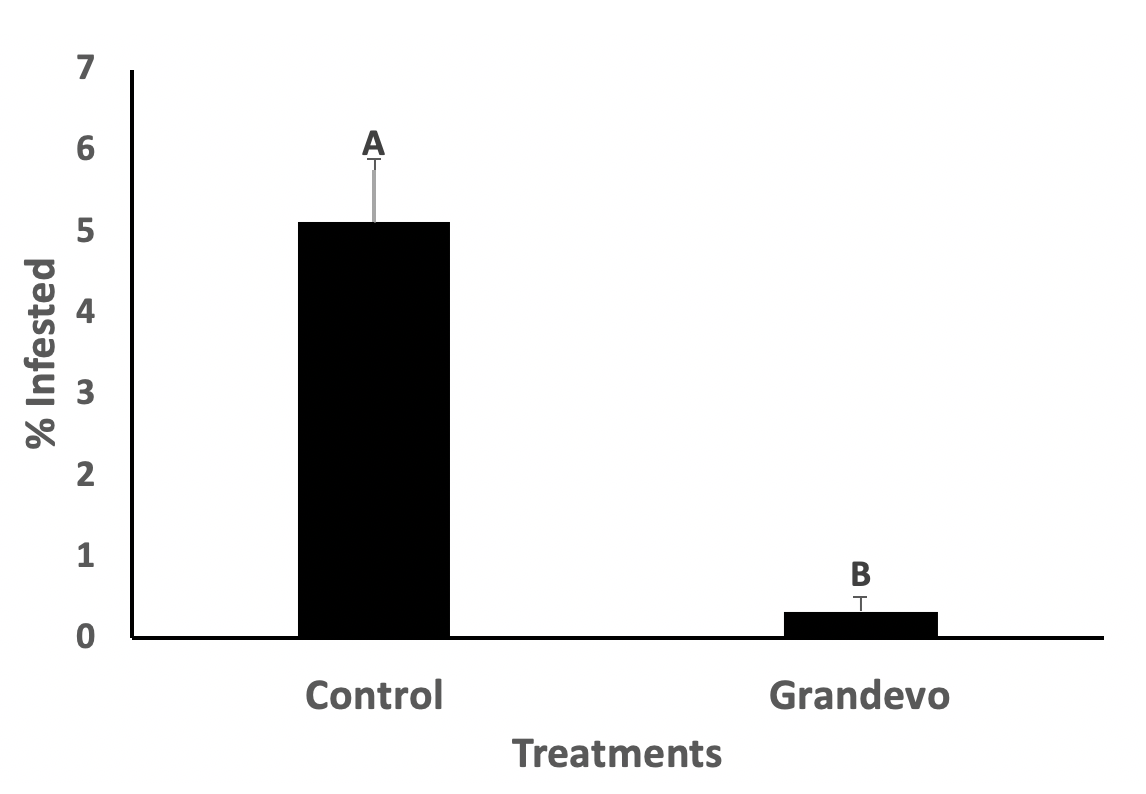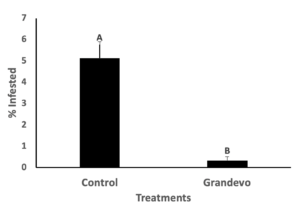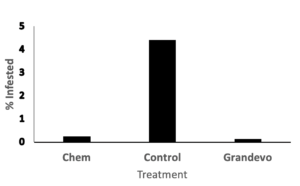Control of Pecan Weevil using reduced rates of Grandevo®, a Microbial Biopesticide

Figure 1—Percentage pecan weevil infestation in 2019 following sequential application of the microbial-based pesticide Grandevo® (based on Chromobacterium subtsugae) at 2 pounds per acre. The control was not treated with any insecticides.
Summary:
- Pecan weevil is an important pest in pecan
- Broad-spectrum chemical insecticides used to control pecan weevil can harm the environment and cause pecan aphid flare-ups.
- Grandevo is a natural bacteria-based bio-insecticide.
- In this study, we showed that a reduced rate of Grandevo, 2 pounds per acre (or 2 quarts per acre), can provide high levels of pecan weevil control (>90%) when applied to the tree canopy.
Introduction:
The pecan weevil, Curculio caryae (Horn), is an important pest of pecans (Harris, 1985). Weevils have a two- or three-year life cycle. Most adult weevils emerge from soil beneath trees from late July through September to feed on and oviposit in the developing fruit. Mature larvae drop to the ground, burrow to a depth of about 2 to 10 inches (8-25 cm) and form a protective soil cell for overwintering. During the following autumn, approximately 90% of the insects pupate and spend the next nine months as adults before emerging (Harris 1985). The remaining insects spend about two years in the soil as larvae and emerge as adults in the third year.
Currently, control recommendations for pecan weevil consist primarily of chemical insecticide applications to the tree canopy to suppress adult insects (e.g., carbaryl and certain pyrethroids) (Acebes et al., 2021). Although these chemical insecticide applications effectively control pecan weevil in conventionally managed orchards, knowledge regarding pecan weevil management in organic pecan systems is lacking. Moreover, aphid and mite resurgence often result from chemical insecticide applications that target pecan weevil (due to destruction of aphid’s natural enemies) (Dutcher and Payne, 1985). Due to these factors and other environmental and regulatory issues, agriculture needs research on developing alternative control strategies in both organic and conventional systems.
In prior research, we discovered that the microbial insecticide Grandevo (based on Chromobacterium subtsugae) applied in pecan orchards at 3 pounds per acre controls pecan weevil at the same levels compared with recommended chemical insecticides (Shapiro-Ilan et al. 2017). Additionally, Grandevo applications conserved natural enemies and reduced populations of black pecan aphid, Melanocallis caryaefoliae (Davis) (Hemiptera: Aphididae) (Oliveira-Hofman et al., 2021). However, the cost of 3 pounds per acre of Grandevo is prohibitive to most growers. Thus, our objective for this study was to determine how a lower rate of Grandevo could control pecan weevil under field conditions.
Methods:
The experiments were conducted in 2019 and 2020 in pecan orchards at the USDA-ARS Southeastern Fruit and Tree Nut Research Station in Byron, Georgia. The experimental design and methodology were based on previous studies conducted by Shapiro-Ilan et al. (2017) and Oliveira-Hofman et al. (2021). The study consisted of four blocks (approximately 2.5 acres each) separated by at least 300 feet. Blocks 1 and 2 contained a mix of ‘Stuart’ and ‘Schley’ trees about 70 years old, while block 3 had 32-year-old trees consisting of ‘Cheyenne,’ ‘Sumner,’ and ‘Farley.’ Block 4 consisted of 80-year-old ‘Moneymaker’ trees. No insecticide sprays were applied in the blocks other than those described below.
Blocks 1 and 3 were split in half such that one-half received the treatment (Grandevo) and the other was the control (no treatment). In blocks 2 and 4, the areas were split into three sections, with Grandevo applied in one section, standard chemical regimes for pecan weevil applied in another (carbaryl and pyrethroids, Acebes et al. 2021), and a control (no treatment) in the third. Researchers did not apply chemical insecticides in blocks 1 and 3 because these plots are managed organically.
Grandevo was obtained from Marrone Bio Innovations. In 2019, a granular formulation of Grandevo was applied at 2 pounds per acre; in 2020, a liquid formulation was applied at 2 quarts per acre. The manufacturer deemed the 2-pound and 2-quart rates to be equivalent. Four applications were made each year (between Aug. 16 and Oct. 4, 2019, and between Aug. 9 and Sept. 20, 2020). Applications were made with approximately the same interval and were timed based on emergence captures of adult weevils in Circle traps (Shapiro-Ilan et al., 2017).
Researchers assessed the efficacy of these treatments by determining the percentage of nuts infested with pecan weevil after harvest. Nuts were harvested from November to January each year. In 2019, at least 95 nuts were randomly sampled per treatment, and in 2020, 400 nuts were randomly sampled per treatment (100 per plot). The difference in the number of nuts sampled in the two years was based on a substantially lower crop load in 2019. Nuts with pecan weevil exit holes were counted as infested. The remaining nuts were cracked and checked for pecan weevil larvae.
The data were evaluated using standard statistical analysis (two-way ANOVA) based on the percentage weevil infested nuts.
Results and Discussion:

Figure 2—Percentage pecan weevil infestation in 2020 following sequential application of the microbial-based pesticide Grandevo® (based on Chromobacterium subtsugae) at 2 quarts per acre. The control was not treated with any insecticides.
In both 2019 and 2020, the Grandevo treatment significantly reduced the percentage of infested nuts (Figures 1 & 2). Additionally, Abbott’s formula applied to the data (Abbott 1925) indicated 93% control each year. In blocks where chemical insecticides were also applied (blocks 2 and 4), the Grandevo applications did just as well as the standard pesticides (Figure 3; statistics not applied given there were only two plots receiving chemical insecticides).

Figure 3—Percentage pecan weevil infestation in 2020 following sequential application of the microbial-based pesticide Grandevo® (based on Chromobacterium subtsugae) at 2 quarts per acre. The control was not treated with any insecticides. Chem = standard chemical insecticide regime (based on the Georgia Pecan Spray Guide).
In conclusion, the reduced rate of Grandevo (2 pounds per acre or 2 quarts per acre) was highly effective in reducing pecan weevil damage in both years of the study. Therefore, relative to prior research indicating efficacy with 3 pounds per acre, the lower rates of Grandevo increase the economic feasibility of this management approach. This current research and the recent findings that Grandevo also contributes to black pecan aphid reduction (as opposed to flaring aphids as often observed when using chemical treatments for pecan weevil) suggest that Grandevo is an attractive option for pecan weevil control.
Acknowledgments. We thank Stacy Byrd and Danny Howard for their technical assistance. Mention of a proprietary product name does not imply USDA’s approval of the product to the exclusion of others that may be suitable.

